dAu200 (2008)
Some studies were done initially to get a good guess at the SpaceCharge in dAu.
There were some concerns from the You do not have access to view this node regarding offsets in the measurement of the GridLeak distortion, which we tried to use You do not have access to view this node to correct (albeit unsuccessfully). This was eventually You do not have access to view this node.
Results of the original calibration:
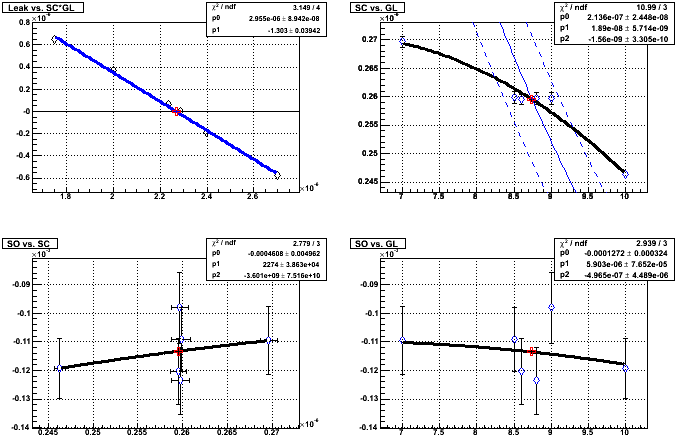
Processing Calib_SC_GL.C("inputs/input1.dat","dca>-5",2)...
Found 6 dataset specifications.
64 files added from hists/hists3.0_9.0/Hist*
65 files added from hists/hists2.5_7.0/Hist*
64 files added from hists/hists2.82_8.5/Hist*
1 files added from hists/HIST2.6_8.6*
65 files added from hists/hists2.0_10.0/Hist*
63 files added from hists/hists2.6_8.8/Hist*
* Constraint on SC x GL = 2.27e-06 +/- 9.71e-08
* Guesses on SC = 2.57e-07 , 2.6e-07 , 1.54e-07 , -2e-07
* Guesses on GL = 8.82 , 14.7 , 8.74 , -11.3
* Guesses on SO = 438 , 436
*** FINAL CALIBRATION VALUES: ***
SC = 2.6e-07 * ((zdcx) - ( 437)) with GL = 8.74
A test production was run in July, and the QA of that data showed You do not have access to view this node. The good news was that the backgrounds appeared to be not localized to any one part of the TPC (signed DCAs were consistently off at all phi for high background data), and remaining gap distortions appeared to be roughly linearly proportional to remaining DCAs.
The calibration was modified to use a principal components analysis using the TPrincipal class. In the process, two bugs (one and two) were found in the TPrincipal class and are only corrected in ROOT versions 5.21 and later. The analysis was tested using the same input as for the original calibration and came up with similar results, so it was deemed viable:
SC = 2.53e-07 * ((zdcx) - ( 266))
The analysis used eight scalers ("zdcx:zdcw:zdce:bbcx:bbcw:bbce:bbcbb:bbcyb") to determine what combinations provided the least variance in measured SpaceCharge (which equals SpaceCharge used to correct the data plus SpaceCharge converted from remaining observed signed DCAs). As in the original calibration, zdcx was the clear choice among those for using only one scaler. It was also found that combinations of zdcx and bbcbb did best among the two scaler options, and not much further improvement resulted from using three or more scalers.
However, no options were found which did a good job of satisfying the entire dAu dataset when using the full test production sample. Early and late runs appeared to require different calibrations, as can be seen in this plot of measured SpaceCharge vs. BBC blue background, where blue/red points are from runs before/after 9004000 respectively when using the best calibration from the full dataset.

So separate calibrations were done for runs prior to and after 9004000. Again, the two scaler calibration using zdcx and bbcbb appeared to be just about as good as anything with more scalers. One other note is that the StSpaceChargeEbyEMaker code had an upper limit in its histograms for SpaceCharge of 0.025, which resulted in getting erroneous fits to the measured amount of SpaceCharge at the very highest luminosities, and I had to cut out anything with a measured SpaceCharge above 0.020. So the Here are the results:
SC = (2.57852e-07*(zdcx-1490.565143))+(3.14451e-08*bbcbb) {run < 9004000}
SC = (2.21883e-07*(zdcx-3886.606142))+(1.58750e-07*bbcbb) {run > 9004000}
Here then is the remaining measured SpaceCharge versus bbcbb and zdcx (left and right within pair) for the pre and post 9004000 dAu runs (upper and lower pairs) where the color represents days (blue is earliest days, red is latest days):

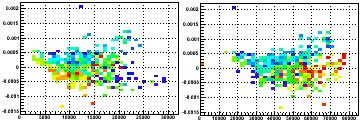
The pre 9004000 runs show that nearly all dependencies are removed. Also, this calibration moves the low luminosity fill away from zero, so the original calibration above will be kept for the low luminosity fill because that does zero the data.
For the post 9004000 runs data, there still seems to be some dependency which I have not gotten rid of in this analysis (I have tried using more scalers and it does not help). There appears to be potential for dividing the data into two further subsets in time, and I'm still exploring that possibility. But the level of calibration looks pretty good already.
dAu(2008) with new alignment
Hao Qiu was able to calibrate alignment of the TPC sectors for Run 8, but this has not yet been used for large scale data production as the calibration arrived too late to assess (and re-calibrate TPC SpaceCharge+GridLeak) in time for the start of the P08ic productions of Run 8 data. The decision not to wait for that assessment was based partially on a naive expectation that the alignment changes were likely inconsequential to physics.
A couple issues were identified in analyses of the P08ic production of dAu data: You do not have access to view this node and inexplicable
Unfortunately, the P08ie production appears not to have solved the h-/h+ ratio problem, while a test production processed using Hao's updated alignment for the TPC did appear to be helpful for both
Progress was made on the alignment assessment and You do not have access to view this node by performing the alignment calibration on both Run 7 and Run 9 data as well. The results gave confidence to the calibration, readying us for the next step of re-calibrating the Run 8 TPC SpaceCharge and GridLeak, which is what I present here.
In order to use the new PCA method of multi-scaler SpaceCharge calibration in combination with the older method of single scaler SpaceCharge+GridLeak calibration, I had to update the Calib_SC_GL.C macro to use luminosity measures which include several scalers. I also updated the code to try to exclude some pileup data via a cut that at used vertex have at least one track matched to the BEMC. The PCA method introduced three periods which needed to be calibrated separately (runs before 9004000, between 9004000 and 9016000, and after 9016000). I have chosen to re-calibrate the third period.
After several passes on the data, I have found the following calibration to be stable:
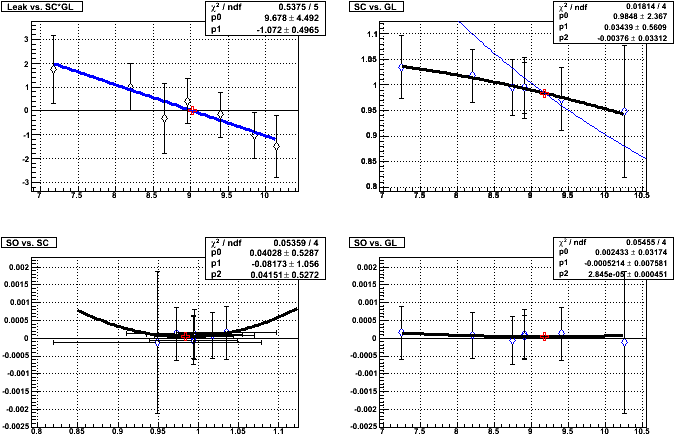
* Constraint on SC x GL = 9.024 +/- 5.916 * Guesses on SC = 0.984 , 0.9839 , 0.5583 , -0.5574 * Guesses on GL = 9.171 , 16.16 , 9.172 , -16.19 * Guesses on SO = -4.523e-05 , -3.997e-05 *** FINAL CALIBRATION VALUES: *** SC = (2.563e-07*(zdcx-(-54.3)))+(-4.822e-08*zdcw)+(1.9094e-08*bbcw) with GL = 9.17
This is a slight increase in the GridLeak relation to SpaceCharge (by ~5%), and a slight increase in the SpaceCharge correction itself over the previously used measure (by ~1%):
SC = (3.56937e-07*(zdcx-582.871654))+(-4.04788e-08*zdce)+(1.20216e-07*bbcbb) with GL = 8.74
Perhaps also worthy of note is that the scaler offset from zero is small with the new calibration (~54 vs. ~583), likely reflecting that some of the previously calibrated offset was in fact alignment related.
Both the alignment and the SpaceCharge+GridLeak corrections have now been entered into the database with entryTimes of 2009-05-22. Note that for now, I have made the Run 8 alignment entries applicable for all of Run 8 (and Run 9), despite that the TPC SpaceCharge+GridLeak calibrations have not yet been re-done for earlier dAu data from Run 8, nor the pp & low energy AuAu running from later in Run 8.
-Gene
________
Updated on May 27, 2009:
Period II spans days 004-015.
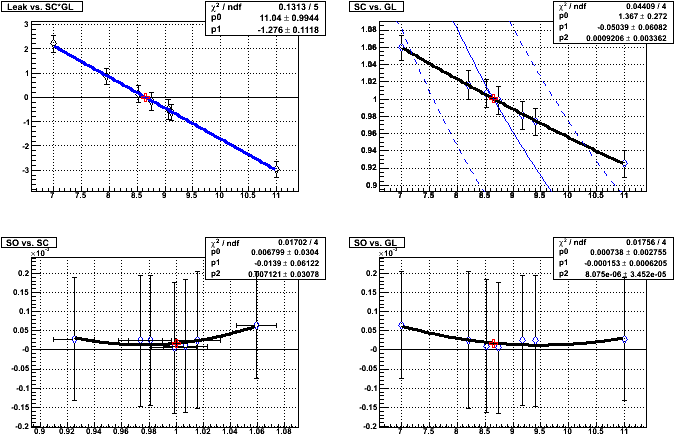
* Constraint on SC x GL = 8.652 +/- 1.087 * Guesses on SC = 1.002 , 1 * Guesses on GL = 8.634 , 8.649 * Guesses on SO = -1.829e-05 , -1.751e-05 *** FINAL CALIBRATION VALUES: *** SC = (3.15e-7*(zdcx-(-1331)))+(-6.056e-08*zdcw)+(1.808e-08*bbcw)) with GL = 8.65
Now in the DB.
-Gene
dAu200 (2008) SpaceCharge calibration quality check
The improved SpaceCharge calibration from August 2008 was used in the P08ie productions of Run 8 dAu data. To verify that it did what was expected, I regenerated the plot of signed DCA distributions as dAu200 (2008). This sample is predominantly data recorded in January 2008. The result is shown here:

This looks similar to the "after" estimate with the exception of the red point with a signed DCA of 0.33cm (despite it, the mean DCA is within 52 microns of zero). This outlier point is a notable example of the fact that this production did not automatically handle stuck RICH scalers (see the mention earlier on this page of the anomalous RICH scalers as well as a more thorough discussion Finding a cut for corrupt scalers in Run 8 dAu).
In more detail, the outlier point is from run 9023014, during which the ZDC east scaler got stuck, clearly seen in the following plot (black points are mean DCA vs. event number, and the red histogram denotes when the timestamp of the event changes by a second, serving as a clock to show the stuck data lasting only a couple seconds):

So a portion of this run's data (about 70 events out of the 400 which I examined in this file alone) has been corrected improperly, leading to signed DCAs of about 1 cm. Such data is unusable for physics and should be discarded. I therefore re-ran the data using Cutting events with corrupt RICH scalers in analyses which have been found to help and the results are slightly better:
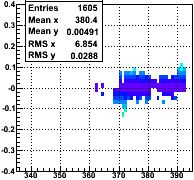
So the improved SpaceCharge calibration is certainly effective as determined by the measure of mean signed DCAs, with the caveat that the RICH scaler cuts need to be used for the P08ie production.
However, this is not the only indicator of the calibration performance. In particular, the width of the signed DCA distribution can be informative and was used to study performance in You do not have access to view this node:
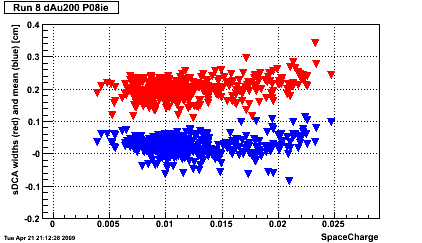
There are two things to note about this plot:
- The means are offset from zero a bit, inconsistent with the plot shown earlier on this page. The plot was made with (in principle) the same data and I am still looking into this difference.
- The widths are generally in the range of about 0.2 cm, notably larger than they were in You do not have access to view this node. This also needs some further understanding.
-Gene